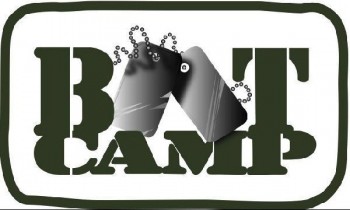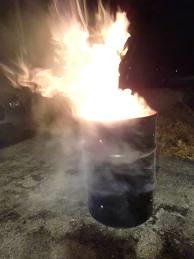 Another small portion of our 200 page “Jump Team Boot Camp” training manual – Next Class Is Scheduled for April 2014
Another small portion of our 200 page “Jump Team Boot Camp” training manual – Next Class Is Scheduled for April 2014
(Be sure to read earlier blogs concerning other aspects of emergency communications and the blog about the upcoming “Jump Team Boot Camp” , a 3 day “get down and dirty” training course.)
by Bob Hejl W2IK
In 1998, I was airlifted via National Guard helicopter to supply emergency communications out of a medium size town in upstate New York. The town had been cut off in every way from the outside world due to an ice storm. Talk about improvising! Talk about pressure! I was lucky enough to find some very helpful people who went out of their way to make sure my communications deployment was successful.
We took turns siphoning fuel from trucks so the two generators could be kept running to supply lights, power to run the boiler system for heat and radio power at the local school which acted as a shelter and gathering place where news could be disseminated. Many of the local homes had wood stoves or fireplaces for heat, but there were some that did not and although  many who didn’t were invited into neighbor’s homes, about 100 opted to stay at the shelter.
many who didn’t were invited into neighbor’s homes, about 100 opted to stay at the shelter.
Since many people were hanging out in the area outside the school, I even suggested that if we had some empty 55 gallon drums we could get some heat from wood burning just like you’ve seen in depression movies. (outdoors, of course) A few minutes later several drums were there, in place, fueled with wood and lit. Neighbors who hadn’t seen or talked to each other in a while were standing around these lit barrels trading stories and getting caught up on “local news”. It made everyone feel as if it were one big winter block party! Everyone in the town contributed what they could to help their neighbors weather this event.
I kept in constant contact, via 40 meters, to the state capitol, giving them updates, requests and getting news and answers to questions. The ground was frozen solid so using stakes to erect an antenna was impossible. I had to lash my antenna’s center pole (using bungee cords) to a truck body while keeping the antenna ends secured with cement blocks. After almost a week, the roads were again open but through it all I improvised whenever there was a problem which needed a solution.
During the World Trade Center Disaster, my second tour had me doing communications at a Red Cross shelter. Although it didn’t come to pass, at that time we weren’t getting any clean towels so the evacuees could dry themselves after showering at the evac center which was located in a school. Upon observation, I noticed that a local hotel had donated boxes containing many terry-cloth bath robes which would have made excellent drying medium, so I made the suggestion which was agreed upon. However, a few minutes later, towels finally arrived.
 Problem solving is but one task that emergency operators who deploy to an unknown location need to have. There needs to be a little “MacGyver” in all of us. Always be aware of where you are, what you are doing, what other resources are around you to take advantage of should things change. Each emergency event will produce it’s own unique set of parameters. By experience you’ll come to realize what they are and how to cope with them.
Problem solving is but one task that emergency operators who deploy to an unknown location need to have. There needs to be a little “MacGyver” in all of us. Always be aware of where you are, what you are doing, what other resources are around you to take advantage of should things change. Each emergency event will produce it’s own unique set of parameters. By experience you’ll come to realize what they are and how to cope with them.
As much as we’d like to think we are trained and prepared for any emergency which might require our communications skills, there will be times that test both the limits of our knowledge and equipment capabilities. When this happens, we either adapt or fail.
 When you deploy to even a “simple site”, such as an evacuation center which was opened due to a hurricane, you’ll need to not only find a location to set up your station, but you’ll also need to make plans should your initial area become unusable such as if a window breaks or flooding makes it impossible to use.
When you deploy to even a “simple site”, such as an evacuation center which was opened due to a hurricane, you’ll need to not only find a location to set up your station, but you’ll also need to make plans should your initial area become unusable such as if a window breaks or flooding makes it impossible to use.
So it would be wise to inspect the building for a secondary location. Try to find such a location which requires little change in your station set up. By this I mean you should find another spot which will allow the easiest erection of your antenna and still remain close to where you are needed. This becomes even more important when your Jump Team deploys far from home.
In 2001, when I was deployed at WTC “Ground Zero”, I had to set up my station on the third floor of the building being used as the Incident Command Center. This was not by my choice, but by necessity. The street level was in an area which we call an “RF hole” because all of the metal buildings surrounding the area impeded signals at such a low elevation. The second floor was being used as a debriefing area.
Although I hated my location, it was the only close area which I deemed usable. The dust from the collapsed buildings migrated into the room I was in and covered both myself and my equipment. I can’t even count the times I washed the dust off of me. I improvised a covering for my equipment out of a roll of brown paper from the classroom. You probably won’t be faced with this type of hardship when you deploy. It is merely an example of to what lengths you might have to go through to get your signal out.
In retrospect, as far as putting out a signal was concerned, if I had a long run of coax it would have made a world of difference as I could have had my radio down on the first floor with my antenna on the third level. If I ever have another “downtown” New York City deployment, I’ll remember to bring that extra run of cable. I suggest you prepare for the same.
If you have what you would consider a valid suggestion or idea which ranges beyond your communications duties, I say bring up that suggestion in a friendly manner which conveys the feeling to others that “we are all in this together”.
However, it’s not your call to make the decision. Don’t interfere with the operations of any duty site, just point out possible options which might have been overlooked. During the stress of an event sometimes people in-charge are thinking about too many things to see that there might be a simple solution to a problem. Ever hear of the “Ferme Method”? This is basically a method by which a complex problem can usually be solved by breaking it down into smaller more manageable problems. In other words something which seems insurmountable can be taken care of by taking smaller steps towards reaching that larger goal.

August 9th, 2013 at 12:39 AM
RT @N5NTG: Improvising During An Emergency Communications Deployment:
Another small portion of ou… http://t.co/ay25x9C65Q
August 9th, 2013 at 5:44 AM
Keep em coming! Great material!